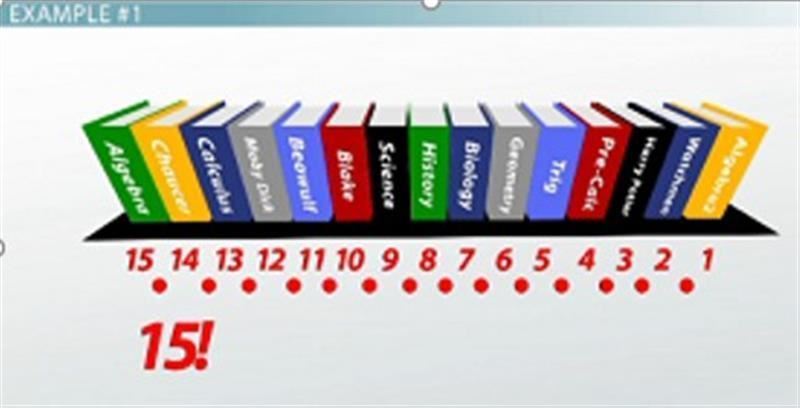The Fundamental Counting Principle
What we just did is actually called the fundamental counting principle. It tells us that when we are presented with a long list of possibilities, and we're trying to count up how many total outcomes might happen, we can simply multiply by how many possibilities there are at each step of the way. It won't always be the case that the numbers we're multiplying by are decreasing by 1 each step, but it does end up happening a lot. It happens so often, in fact, that mathematicians decided to give the operation its own name, factorial.
Factorial
We denote factorial with an exclamation point, and it simply tells us to multiply any natural number by all the natural numbers that are smaller than it. If we're asked to evaluate 5!, I simply have to do 5 × 4 × 3 × 2 × 1, and I get 120. 9! is 9 × 8 × 7 × 6 × 5 × 4 × 3 × 2 × 1 =362,880. 20! is 20 × 19 × 18 × 17 × 16 all the way to 3 × 2 × 1 and I get this outrageous number 24329... on and on and on. As you can see, factorials get real big real quick.
Along with helping us answer questions like 'how many different ways could these people finish the race?', a factorial can also be used for questions having to do with arranging things.
Example No 1
For example, how many different ways could I arrange my 15 favorite books on my shelf? Well, there are 15 books that could go on the shelf first, there are 14 books that could go on it second... after we've put the first two on there, now there are only 13 left in the pile that could go on third, and so on and so on. So, the fundamental counting principle says that my answer is just going to be 15 × 14 × 13 all the way down to 1, which is just 15!. It turns out that 15! is a little over one trillion different ways, which is quite a few ways that I could arrange those books.

The exclamation point means to multiply that number by all numbers smaller than it
Example No 2
Or maybe I would be asked how many ways I could order the 12 songs that I'm putting on my playlist. Well, there are 12 different songs that I could choose to be the first song, there are 11 different songs that I could choose to be second and there are ten different songs that I could choose to be third. So, the answer to this one is 12!, which looks to be about 479,001,600different ways I could make this playlist.
As you can see, factorial comes up in a lot of places. To get more practice with it in some more complicated examples, check out the other factorial video that has some practice problems.
Lesson Review
To review, the fundamental counting principle tells us that to calculate the total number of ways something can happen, we simply multiply together the number of ways each step can happen. Factorial is the operation of multiplying any natural number with all the natural numbers that are smaller than it, giving us the mathematical definition n! = n × (n - 1) × (n - 2) × (n - 3) .... Lastly, factorial is used for questions that ask you to find how many ways you can arrange or order a set number of things.
Lesson Objectives
Once you complete this lesson you'll be able to:
- Define the fundamental counting principle
- Calculate the total number of ways something can happen
- Understand what a factorial is
- Comprehend how you can use factorials to determine how many ways you a set number of things can be ordered